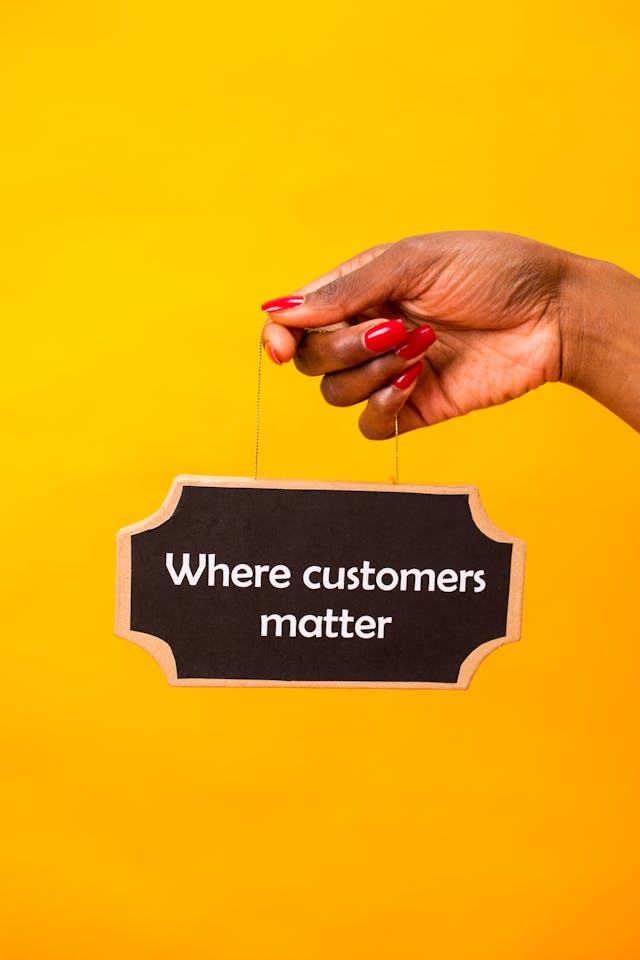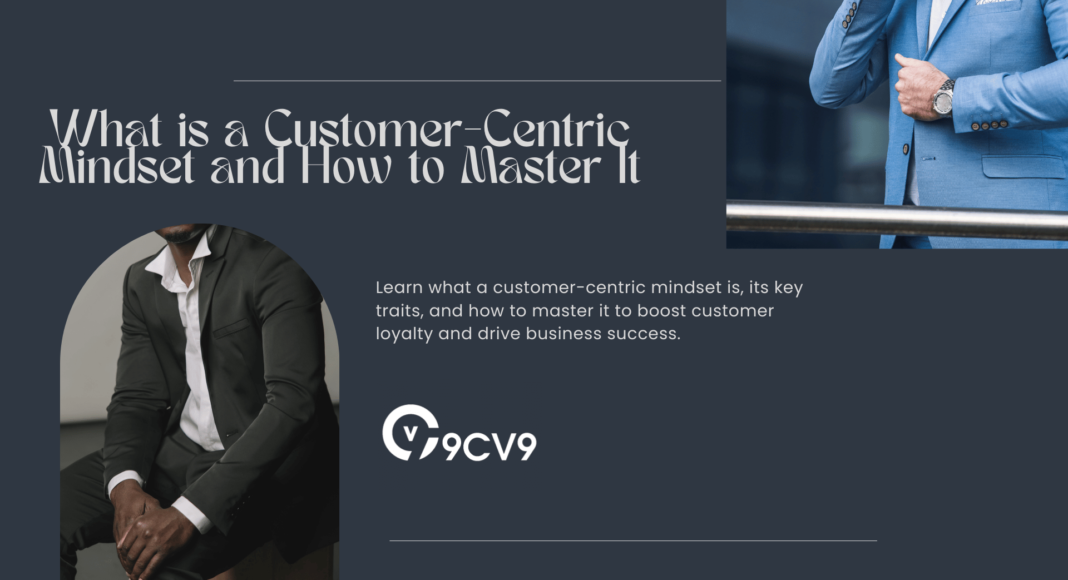Key Takeaways
- A customer-centric mindset prioritizes customer needs, creating better experiences that drive loyalty, retention, and long-term business success.
- Key traits of a customer-centric mindset include empathy, personalization, and responsiveness, which help foster deeper customer relationships.
- To master a customer-centric mindset, businesses must implement strategies like employee training, feedback loops, and data-driven personalization to continuously improve customer experience.
In today’s highly competitive and ever-evolving business landscape, organizations must prioritize their customers to stay relevant and thrive.
One of the most powerful ways to achieve this is by adopting a customer-centric mindset.
But what exactly does it mean to be customer-centric, and how can businesses master this approach to drive growth, build loyalty, and improve customer experiences?

A customer-centric mindset refers to an organizational philosophy that places the customer at the heart of every decision, process, and action.
Rather than focusing solely on products, services, or profits, a customer-centric approach emphasizes understanding and meeting the needs, preferences, and expectations of customers.
It’s about creating value for customers at every touchpoint, from initial interactions to post-purchase support, ensuring that their experiences are consistently positive and personalized.
In short, businesses with a customer-centric mindset see their customers not just as transactions but as long-term relationships that need nurturing, attention, and care.
Why is this mindset so crucial in today’s business world?
The answer lies in the changing dynamics of consumer behavior.
Modern customers are more informed, empowered, and vocal than ever before, thanks to the rise of digital platforms, social media, and easy access to vast amounts of information.
They expect companies to anticipate their needs, offer personalized experiences, and provide exceptional service every step of the way.
With the ever-growing number of options available to them, customers are less likely to remain loyal to brands that fail to meet these expectations.
Research consistently shows that customer-centric businesses outperform their competitors in terms of customer retention, satisfaction, and revenue growth.
According to a report by Deloitte, customer-centric companies are 60% more profitable than those that don’t prioritize customer experience.
Additionally, these businesses enjoy higher customer loyalty and greater market share, as customers are more likely to stick with brands that consistently deliver on their promises.
As such, shifting to a customer-centric mindset isn’t just about improving customer service—it’s a strategic business move that has a direct impact on the bottom line.
But transitioning to a customer-centric organization doesn’t happen overnight.
It requires a fundamental shift in company culture, from top leadership down to every employee.
It involves understanding what customers truly want, actively listening to their feedback, and creating experiences that reflect their values and needs.
Moreover, it requires leveraging technology, data, and customer insights to better understand their behaviors and preferences, allowing businesses to continuously adapt and improve.
In this blog, we’ll explore what it truly means to have a customer-centric mindset, why it’s more important than ever, and how companies can take actionable steps to master it.
From fostering a customer-first culture within your organization to using advanced technologies to personalize customer experiences, we’ll cover all the key strategies and best practices that will enable you to put your customers at the center of your business strategy.
If you’re ready to learn how to build and maintain a customer-centric mindset that fuels sustainable growth, enhance customer satisfaction, and create meaningful connections with your audience, read on.
Before we venture further into this article, we would like to share who we are and what we do.
About 9cv9
9cv9 is a business tech startup based in Singapore and Asia, with a strong presence all over the world.
With over eight years of startup and business experience, and being highly involved in connecting with thousands of companies and startups, the 9cv9 team has listed some important learning points in this overview of What is a Customer-Centric Mindset and How to Master It.
If your company needs recruitment and headhunting services to hire top-quality employees, you can use 9cv9 headhunting and recruitment services to hire top talents and candidates. Find out more here, or send over an email to [email protected].
Or just post 1 free job posting here at 9cv9 Hiring Portal in under 10 minutes.
What is a Customer-Centric Mindset and How to Master It
- What is a Customer-Centric Mindset?
- Key Characteristics of a Customer-Centric Mindset
- How to Develop and Master a Customer-Centric Mindset
- Challenges in Adopting a Customer-Centric Mindset
- Measuring the Impact of a Customer-Centric Mindset
1. What is a Customer-Centric Mindset?

A customer-centric mindset is an organizational approach that prioritizes understanding, meeting, and exceeding customer expectations in every aspect of business operations.
This mindset goes beyond customer service—it influences product development, marketing strategies, and the way employees interact with customers at every touchpoint.
It requires businesses to view everything through the lens of the customer, ensuring that customer satisfaction is at the core of all decisions.
In simple terms, a customer-centric organization focuses on creating value for customers, building long-term relationships, and fostering loyalty.
This is achieved by aligning business strategies with customer needs, preferences, and expectations, thereby ensuring a positive and consistent experience at every interaction.
Core Principles of a Customer-Centric Mindset
A customer-centric mindset is underpinned by a few core principles that guide an organization in its pursuit of exceptional customer experience and satisfaction.
1. Empathy for the Customer
- Understanding customers’ pain points and needs is fundamental to delivering a truly customer-centric experience.
- Putting yourself in the customer’s shoes helps businesses tailor solutions that resonate and address their specific challenges.
- Example: Zappos, known for its exceptional customer service, empowers its customer service team to go the extra mile, including offering full refunds without requiring a return, to ensure that every customer feels valued and heard.
2. Customer Understanding through Data
- Gathering and analyzing customer data—such as purchase history, preferences, and feedback—helps businesses personalize interactions.
- Businesses should leverage insights from data analytics to forecast customer needs and provide proactive solutions.
- Example: Amazon uses customer browsing and purchasing data to provide tailored product recommendations, significantly enhancing the shopping experience and driving sales.
3. Personalization at Every Touchpoint
- Customers expect individualized experiences based on their unique behaviors, preferences, and interactions with the brand.
- Personalizing customer communications, product offerings, and even marketing efforts fosters a deeper connection.
- Example: Spotify creates personalized playlists for its users based on listening habits, enhancing engagement and customer loyalty.
4. Consistent Communication
- A customer-centric approach means being available and responsive at all times, whether through customer service channels or social media.
- Consistency in communication builds trust and shows customers that their feedback is valued.
- Example: Apple’s customer support team ensures that customers receive timely assistance across all channels, maintaining a positive brand experience and customer satisfaction.
5. Continuous Feedback and Improvement
- Customer-centric companies actively seek feedback through surveys, reviews, and direct interactions, using it to improve their services.
- This feedback loop ensures that businesses evolve according to customers’ changing preferences.
- Example: Tesla uses customer feedback to continuously improve vehicle software, offering over-the-air updates and addressing any user concerns promptly.
The Difference Between Customer-Centric vs. Product-Centric Organizations
A product-centric organization focuses primarily on developing and selling a great product, often with little regard for the customer’s broader experience. In contrast, a customer-centric organization places the customer’s needs and satisfaction at the center of every decision, from product development to customer service.
Product-Centric Characteristics:
- Primarily focused on product features and innovation.
- Marketing and sales strategies emphasize the product’s technical superiority.
- Customer support may be secondary to the product itself.
Customer-Centric Characteristics:
- Focuses on understanding and addressing customer pain points.
- Emphasizes long-term customer relationships over short-term sales.
- Customer satisfaction is integral to the product’s success and the overall business strategy.
Example of a Shift from Product-Centric to Customer-Centric:
- Nike shifted from a product-centric focus to a customer-centric approach by embracing digital transformation. With the launch of Nike Training Club and Nike Run Club apps, the company moved beyond simply selling shoes to offering personalized fitness experiences, engaging with customers on a deeper, more valuable level.
The Role of Leadership in Fostering a Customer-Centric Mindset
The leadership team plays a critical role in creating a culture that values customers and puts them at the heart of business strategies.
1. Aligning Company Vision with Customer Needs
- Senior leadership must align the company’s mission with a customer-first approach, ensuring that all business functions are focused on delivering value to customers.
- Leaders should prioritize customer-centric values in company policies, training programs, and decision-making processes.
2. Empowering Employees
- Leaders must empower employees to act in the best interest of the customer, whether that means making exceptions, solving problems, or providing personalized solutions.
- Employee training should focus on empathy, communication skills, and product knowledge to ensure seamless customer interactions.
Example:
- Southwest Airlines is known for its strong customer-centric leadership. The company has a clear customer-first culture that is continuously reinforced by leadership through employee empowerment and customer-focused decisions, such as allowing free checked bags.
Examples of Companies Demonstrating a Customer-Centric Mindset
Several organizations have set the standard for what it means to be truly customer-centric, consistently prioritizing customer satisfaction and personalizing experiences.
1. Amazon
- Amazon is often hailed as one of the most customer-centric companies in the world. Its focus on customer satisfaction is reflected in its easy-to-use platform, fast delivery options, and personalized recommendationsbased on browsing and purchase history.
- Customer-first approach: Amazon’s slogan “Earth’s most customer-centric company” is not just marketing—it’s embedded in their culture. They even offer no-questions-asked returns, reinforcing their commitment to customer convenience.
2. Zappos
- Known for its legendary customer service, Zappos goes above and beyond to ensure customers are happy, even if it means offering a full refund without requiring the return of items. This exceptional customer service leads to high customer loyalty and retention.
3. Apple
- Apple’s customer-centric approach is evident in its Apple Store experiences, where employees provide personalized product recommendations and on-the-spot technical support. This focus on the customer journey builds trust and enhances brand loyalty.
Why a Customer-Centric Mindset Matters
Adopting a customer-centric mindset is essential for several reasons:
1. Increased Customer Loyalty
- A customer-first approach builds trust and encourages long-term relationships. Loyal customers are more likely to return and recommend the brand to others, boosting both revenue and brand reputation.
2. Improved Customer Retention
- Businesses that focus on customer satisfaction and consistently meet customer needs have higher retention rates. The cost of retaining existing customers is lower than acquiring new ones, making customer retention a key aspect of profitability.
3. Competitive Advantage
- In an increasingly competitive market, companies that are truly customer-centric stand out. Personalized experiences create deeper emotional connections, making customers more likely to remain loyal even when other options are available.
4. Enhanced Brand Advocacy
- Satisfied customers don’t just stay loyal—they become brand advocates. Word-of-mouth marketing from happy customers is incredibly powerful, often leading to organic growth and new customer acquisition.
Conclusion
A customer-centric mindset is more than just an organizational trend—it’s a business strategy that influences all areas of operation, from product development to marketing and customer service.
By focusing on empathy, personalization, and continuous improvement, companies can build stronger, more meaningful relationships with their customers, leading to enhanced loyalty, competitive advantage, and sustainable growth.
Understanding and mastering a customer-centric mindset can ultimately transform businesses, making customer satisfaction a core pillar of their success.
2. Key Characteristics of a Customer-Centric Mindset

A customer-centric mindset is not just about offering good customer service; it is a comprehensive approach that influences every aspect of business strategy, operations, and culture.
This mindset goes beyond just meeting customer expectations—it’s about anticipating their needs, understanding their pain points, and building long-term, meaningful relationships.
Below are the key characteristics that define a customer-centric mindset, each essential to ensuring an exceptional customer experience and fostering loyalty.
1. Deep Understanding of Customer Needs and Expectations
At the core of a customer-centric mindset is a profound understanding of what customers need and expect from the brand. This characteristic drives all decision-making, ensuring that the company consistently aligns with customer values.
Key Aspects:
- Customer Research: Continuously gather and analyze customer feedback, surveys, reviews, and behavioral data to understand their preferences.
- Customer Segmentation: Identify and cater to different customer segments with tailored strategies to meet diverse needs.
- Anticipating Needs: Rather than just reacting to customer requests, customer-centric businesses strive to anticipate needs before customers even express them.
Example:
- Netflix is a prime example of anticipating customer needs. By analyzing user viewing habits, Netflix not only recommends relevant content but also creates original programming based on what customers are watching, enhancing personalization and engagement.
2. Empathy for the Customer
Empathy is the ability to truly understand and feel the customer’s experience. In a customer-centric organization, empathy is crucial for crafting interactions that resonate with customers on an emotional level.
Key Aspects:
- Active Listening: Employees listen to customer concerns with genuine care and interest, aiming to resolve issues in a personalized manner.
- Understanding Pain Points: Identifying customer frustrations and going above and beyond to address them.
- Personalized Solutions: Offering tailored solutions to meet specific customer needs rather than providing generic responses.
Example:
- Zappos, renowned for its exceptional customer service, empowers its customer service representatives to spend as much time as needed to understand and resolve customer issues. This level of empathy fosters trust and builds long-term customer loyalty.
3. A Strong Focus on Customer Experience (CX)
In a customer-centric mindset, the customer experience (CX) is paramount. Every touchpoint in the customer journey is designed to create a seamless, enjoyable experience.
Key Aspects:
- Omnichannel Consistency: Customers expect a consistent experience across all platforms—whether online, via mobile, or in-store. Customer-centric businesses ensure that their communication and service remain uniform across channels.
- Ease of Use: Simplify processes and remove friction points that could create a negative customer experience.
- Proactive Engagement: Customer-centric businesses engage with customers throughout the entire journey, not just when they need help.
Example:
- Apple has created an exceptional customer experience by designing intuitive products, offering seamless integration across devices, and providing top-tier customer service both online and in-store, making the user journey smooth and enjoyable from start to finish.
4. Personalization
Personalization is an essential feature of a customer-centric mindset. It involves tailoring products, services, and communication to meet the unique needs of individual customers, creating a more relevant and engaging experience.
Key Aspects:
- Customized Offers and Recommendations: Use customer data to offer personalized product recommendations, discounts, or services based on past behaviors.
- Tailored Communication: Use customer preferences to craft individualized email marketing, promotions, and other communications.
- Dynamic Content: Adapt the website, product displays, and advertising to match individual customer preferences and browsing history.
Example:
- Amazon is a leader in personalization. Through its advanced algorithms, Amazon offers product recommendations based on past purchases, browsing history, and even reviews, providing a highly tailored shopping experience for each customer.
5. Continuous Feedback and Improvement
A customer-centric mindset thrives on continuous feedback from customers and uses that feedback to improve products, services, and the overall customer experience.
Key Aspects:
- Customer Surveys and Reviews: Actively seek feedback through surveys, reviews, and focus groups to understand customer sentiment and identify areas for improvement.
- Closed-Loop Feedback: Once feedback is collected, customer-centric organizations ensure that changes are made and customers are informed about improvements.
- Continuous Learning: Encourage an organizational culture that views feedback as an opportunity for growth rather than criticism.
Example:
- Tesla exemplifies continuous feedback integration. Tesla’s CEO, Elon Musk, frequently listens to customer feedback via social media and updates the cars through over-the-air software updates to address issues or improve functionality. This commitment to feedback keeps customers engaged and loyal.
6. Empowered Employees
In customer-centric organizations, employees are empowered to make decisions that benefit the customer, ensuring that the customer’s needs are met quickly and effectively. Empowered employees contribute to a customer-first culture and are crucial for providing exceptional service.
Key Aspects:
- Autonomy in Decision-Making: Allow employees to make decisions that positively impact the customer experience without needing managerial approval for every issue.
- Customer-Focused Training: Provide comprehensive training that equips employees with the tools and knowledge to solve customer problems effectively and empathetically.
- Ownership of Customer Relationships: Employees should take ownership of customer issues and work diligently to resolve them, fostering trust and satisfaction.
Example:
- Ritz-Carlton is known for empowering its employees to take immediate action in solving customer problems. Employees have the authority to spend up to $2,000 to make things right for customers, which ensures a quick, efficient resolution to customer issues and enhances overall satisfaction.
7. Long-Term Relationship Building
A customer-centric mindset focuses on building long-term relationships rather than short-term transactions. The goal is to keep customers happy and loyal, ensuring they return and become advocates for the brand.
Key Aspects:
- Customer Retention: Focus on strategies that nurture existing relationships, such as loyalty programs, personalized offers, or exclusive access to new products.
- Community Engagement: Create opportunities for customers to interact with each other and with the brand, fostering a sense of community.
- Proactive Service: Anticipate future needs and offer solutions before customers ask for them.
Example:
- Starbucks has built a loyal customer base by offering a well-designed loyalty program, engaging customers via mobile apps, and personalizing interactions. The Starbucks Rewards program encourages repeat purchases, fostering customer loyalty by offering personalized perks and discounts.
8. Accountability and Transparency
In a customer-centric mindset, businesses must be transparent and accountable for their actions, particularly when it comes to mistakes or shortcomings. Transparency fosters trust, which is essential for long-term customer loyalty.
Key Aspects:
- Honesty in Communication: Always be upfront with customers, whether it’s about product availability, delays, or changes in service.
- Ownership of Mistakes: If a mistake is made, a customer-centric company takes full responsibility and offers a solution that exceeds expectations.
- Clear Policies: Make sure customers understand policies, from returns to shipping timelines, to avoid confusion or frustration.
Example:
- Patagonia is a brand that prioritizes transparency. In addition to offering high-quality sustainable products, the company is open about its sourcing, labor practices, and environmental impact. This transparency builds trust with environmentally conscious consumers.
9. Innovation and Adaptability
To maintain a customer-centric approach, companies must be open to continuous innovation and adaptability. This characteristic involves responding quickly to market shifts and evolving customer preferences.
Key Aspects:
- Staying Ahead of Trends: Constantly monitor market trends and customer behavior to adapt offerings and stay relevant.
- Flexible Solutions: Be open to experimenting with new products, services, or technologies that could improve the customer experience.
- Adapting to Customer Feedback: Use customer insights to drive innovation, ensuring that changes are aligned with their evolving needs.
Example:
- Spotify is an excellent example of innovation and adaptability. By continuously adding features like personalized playlists and podcast recommendations, Spotify adapts to customer preferences and keeps the service fresh and engaging for users.
Conclusion
The key characteristics of a customer-centric mindset—such as empathy, personalization, continuous improvement, and empowerment—are essential for businesses that want to thrive in today’s competitive market.
By understanding and meeting the needs of customers, adopting an organization-wide customer-first culture, and building long-term relationships, companies can create experiences that foster loyalty and drive business growth.
With companies like Zappos, Amazon, and Ritz-Carlton leading the way, it’s clear that adopting a customer-centric approach is not only beneficial for customers but also for long-term business success.
3. How to Develop and Master a Customer-Centric Mindset
Developing and mastering a customer-centric mindset is essential for organizations that wish to build long-lasting relationships with customers and maintain a competitive edge.
This mindset not only fosters loyalty and satisfaction but also encourages employees to align their behaviors with the goal of consistently providing exceptional customer experiences.
Below are the key steps to cultivate and master a customer-centric mindset within any organization.
1. Understand the Importance of a Customer-Centric Culture
To develop a customer-centric mindset, the first step is to understand why this approach is vital to business success. A customer-centric culture starts with leadership and permeates every level of the organization.
Key Steps:
- Leadership Commitment: Leaders must model customer-centric behaviors by prioritizing customer needs in decision-making and fostering a customer-first culture across all departments.
- Clear Vision and Values: Define a clear customer-centric vision and ensure that all employees understand and align with the company’s core values focused on customer satisfaction.
- Employee Buy-In: Engage employees by emphasizing how their roles directly impact the customer experience, creating a shared sense of purpose.
Example:
- Amazon, under the leadership of Jeff Bezos, created a customer-centric culture from the top down. Bezos famously said, “We start with the customer and work backwards.” This philosophy is ingrained in Amazon’s culture, where every employee, from the CEO to warehouse staff, works with customer needs in mind.
2. Collect and Act on Customer Feedback
A customer-centric mindset is built on continuously gathering insights from customers and responding proactively to their needs. By listening closely to customers, businesses can identify pain points and opportunities for improvement.
Key Steps:
- Conduct Surveys and Polls: Regularly send out surveys, polls, or customer satisfaction questionnaires to understand customers’ experiences, preferences, and expectations.
- Use Social Listening Tools: Leverage social media platforms and online forums to monitor real-time feedback and track customer sentiment.
- Implement Feedback Loops: Create mechanisms to ensure that customer feedback is not only gathered but also acted upon in a timely manner.
Example:
- Apple actively uses customer feedback to improve its products. The company encourages users to submit reviews and suggestions for improvements, which have led to updates in software and hardware over time. Their commitment to acting on feedback helps Apple stay ahead of customer expectations and remain a customer-centric brand.
3. Invest in Employee Training and Empowerment
Employees are the front line when it comes to customer interaction. To master a customer-centric mindset, it’s crucial to invest in comprehensive training that equips employees with the skills to understand, empathize with, and serve customers effectively.
Key Steps:
- Customer Service Training: Provide ongoing customer service training focused on empathy, communication, problem-solving, and conflict resolution.
- Empower Employees: Give employees the autonomy to make decisions that benefit the customer, whether it’s offering a discount, providing an expedited solution, or going above and beyond to resolve an issue.
- Foster Emotional Intelligence: Train employees to recognize and respond to emotional cues in customer interactions, ensuring that every customer feels valued and understood.
Example:
- Zappos, a company known for its exceptional customer service, invests heavily in employee training. Zappos’ customer service representatives are trained to go beyond just solving problems—they are empowered to provide personalized and memorable experiences. This has led to a highly loyal customer base and a reputation for going the extra mile.
4. Leverage Technology to Enhance the Customer Experience
Technology plays a critical role in supporting a customer-centric mindset. By using digital tools and platforms, businesses can streamline customer interactions, personalize services, and gain deeper insights into customer behavior.
Key Steps:
- Implement CRM Systems: Use customer relationship management (CRM) systems to store and analyze customer data, allowing for more personalized interactions and proactive service.
- Automation for Personalization: Leverage automation tools such as email marketing software, chatbots, or AI-driven recommendations to offer tailored experiences and responses at scale.
- Omnichannel Integration: Ensure a seamless experience across all customer touchpoints, including in-store, online, mobile apps, and social media, so customers can interact with the brand however they prefer.
Example:
- Sephora has mastered the use of technology to enhance the customer experience. They use data from their loyalty program, the Sephora Beauty Insider, to personalize recommendations both in-store and online. Additionally, their mobile app integrates with their in-store experience, allowing customers to try virtual makeup before purchasing.
5. Align Products and Services with Customer Needs
Mastering a customer-centric mindset requires businesses to ensure that their products and services are always aligned with evolving customer demands. This step goes beyond simply reacting to customer feedback—it involves proactively designing offerings that meet both existing and future needs.
Key Steps:
- Innovate Based on Insights: Use customer insights and market trends to innovate and create new products or services that address unmet needs.
- Improve Existing Products: Continually assess and refine existing offerings to ensure they continue to meet customer expectations, using feedback and market research to drive product improvements.
- Customer-Centric Product Development: Involve customers in the product development process, either through focus groups, beta testing, or direct input, to ensure products resonate with the target audience.
Example:
- Nike uses customer insights to fuel product development and innovation. Through its Nike Training Club and Nike Running Club apps, the company collects data on how customers use its products and what features they value. This data informs the development of new product lines and improvements to existing products.
6. Foster Cross-Department Collaboration
A customer-centric mindset cannot thrive if customer-focused efforts are isolated within one department. It requires collaboration across all departments to deliver a cohesive, unified customer experience.
Key Steps:
- Breaking Down Silos: Encourage open communication and collaboration between departments such as marketing, sales, customer service, and product development.
- Shared Customer Data: Ensure that customer insights and feedback are accessible across the organization, allowing all departments to tailor their strategies and operations to meet customer needs.
- Collaborative Problem-Solving: When customer issues arise, involve cross-functional teams in brainstorming and implementing solutions that benefit the customer.
Example:
- Spotify demonstrates cross-department collaboration by integrating customer insights from various touchpoints to deliver a seamless user experience. Marketing teams, product developers, and customer support work closely together to address customer needs, creating a unified approach to customer engagement.
7. Measure and Track Customer-Centric KPIs
To master a customer-centric mindset, businesses must establish key performance indicators (KPIs) that measure success in customer satisfaction, loyalty, and engagement. These metrics help track progress and highlight areas for improvement.
Key Steps:
- Customer Satisfaction Scores (CSAT): Use post-interaction surveys or feedback forms to measure customer satisfaction with specific touchpoints.
- Net Promoter Score (NPS): Track customer loyalty and willingness to recommend the brand to others.
- Customer Lifetime Value (CLV): Measure the long-term value a customer brings to the business to understand the effectiveness of customer retention strategies.
Example:
- Salesforce is a leader in customer relationship management and has mastered the use of KPIs to track customer satisfaction. By using its own platform to measure customer engagement and satisfaction, Salesforce ensures its products and services are continually evolving to meet customer needs.
8. Create a Personalized Customer Journey
Mastering a customer-centric mindset means providing a personalized experience for every customer. This involves recognizing the individuality of each customer and tailoring their journey from the first interaction to long-term engagement.
Key Steps:
- Customer Segmentation: Group customers based on behavior, preferences, and needs to tailor marketing, sales, and service efforts.
- Personalized Communication: Use customer data to create personalized emails, offers, and recommendations that resonate with each customer’s unique interests and needs.
- Consistent Experience: Provide a consistent and personalized experience at every touchpoint, ensuring that the customer feels valued at every interaction.
Example:
- Spotify’s use of data to create personalized playlists like “Discover Weekly” and “Wrapped” is a prime example of personalizing the customer journey. Spotify uses listening data to create an experience that feels uniquely tailored to each user, deepening engagement and loyalty.
9. Be Transparent and Build Trust
A customer-centric mindset is rooted in trust. Transparency in business practices, policies, and customer interactions is key to building and maintaining customer trust.
Key Steps:
- Honest Communication: Be clear and honest with customers about product availability, pricing, and any changes that may affect them.
- Accountability: Take responsibility for mistakes and provide timely solutions to address customer issues.
- Transparent Policies: Ensure that policies, especially regarding returns, refunds, and warranties, are clearly communicated and customer-friendly.
Example:
- Patagonia has built a strong reputation for transparency and trust. The company is transparent about its environmental practices, including its sourcing, labor conditions, and sustainability efforts, which resonates with eco-conscious customers.
Conclusion
Mastering a customer-centric mindset is an ongoing process that requires commitment from every level of an organization.
By focusing on understanding customer needs, gathering feedback, empowering employees, leveraging technology, and aligning every department with the goal of delivering exceptional experiences, businesses can foster loyalty, satisfaction, and long-term success.
Companies like Amazon, Zappos, and Apple are prime examples of how a customer-centric mindset can propel a business toward unparalleled growth and customer retention.
Through these strategies, any company can create a customer-first culture that drives results and builds enduring relationships with its clientele.
4. Challenges in Adopting a Customer-Centric Mindset
Adopting a customer-centric mindset is a strategic shift that can lead to improved customer loyalty, satisfaction, and business success.
However, this transition often comes with significant challenges that organizations must address to create a truly customer-first culture.
The journey requires overcoming internal resistance, resource constraints, and aligning various departments toward common goals.
Below are the key challenges businesses face when trying to adopt a customer-centric mindset, along with strategies to overcome them.
1. Resistance to Change Within the Organization
One of the most common barriers to adopting a customer-centric mindset is internal resistance to change. Employees, particularly those who have been accustomed to a product- or sales-driven approach, may find it difficult to shift focus to prioritizing customer needs.
Key Steps to Address Resistance:
- Leadership Buy-In: Senior management must be the driving force behind the customer-centric initiative. By demonstrating commitment through actions, leaders can set the tone for organizational change.
- Communicate the Benefits: Clearly explain the advantages of a customer-centric mindset, such as increased customer loyalty, higher retention rates, and improved long-term profitability.
- Employee Involvement: Involve employees in the transition process by gathering their input on how customer-centric strategies can be implemented in their specific departments. This encourages ownership and reduces resistance.
Example:
- IBM faced internal resistance when shifting towards a customer-centric model. Initially, employees struggled to move away from the company’s traditional technology-first approach. However, through extensive training and leadership commitment, IBM gradually shifted its focus, resulting in more tailored services and products for clients.
2. Lack of Unified Customer Data Across Departments
In a customer-centric organization, accessing comprehensive, real-time customer data is crucial. However, many businesses face challenges due to siloed data, where different departments maintain separate customer databases, leading to fragmented insights and inconsistent experiences.
Key Steps to Overcome Data Silos:
- Implement a Centralized CRM System: Adopt a customer relationship management (CRM) system that consolidates data from sales, marketing, customer support, and other departments into one unified platform.
- Foster Cross-Department Collaboration: Encourage collaboration between departments to ensure that customer insights are shared and used to create a cohesive experience across touchpoints.
- Ensure Data Accessibility: Provide all employees with access to relevant customer data so that they can make informed decisions and interact with customers in a personalized way.
Example:
- Salesforce offers a CRM platform that enables companies to break down data silos by centralizing all customer information in one place. This system empowers teams to work collaboratively and ensures that customers receive consistent service across different touchpoints.
3. Insufficient Resources for Customer-Centric Initiatives
Building a customer-centric culture often requires a significant investment of time, money, and resources. Smaller companies or those with limited budgets may struggle to allocate sufficient resources to customer service, training, or technology upgrades that are necessary for adopting this mindset.
Key Steps to Address Resource Constraints:
- Prioritize Customer-Centric Investments: Focus on the most critical areas that directly impact customer satisfaction, such as improving customer service teams or investing in CRM systems, even if the budget is limited.
- Leverage Cost-Effective Technology: Utilize affordable digital tools and automation software to streamline processes and improve customer experience without overspending.
- Outsource When Necessary: Consider outsourcing certain customer-focused functions, such as customer support or market research, to third-party providers who specialize in these areas.
Example:
- Glossier, a beauty brand, has successfully cultivated a customer-centric culture with relatively modest resources. By focusing on direct customer interaction via social media and customer feedback, Glossier has grown its customer base without relying on traditional marketing or expensive technology.
4. Difficulty in Aligning Company-wide Goals Around the Customer
Creating a customer-centric mindset requires aligning all departments, teams, and individuals around the same core goal: improving the customer experience. This can be a difficult challenge for organizations, especially large ones with multiple departments or teams that may have competing priorities.
Key Steps to Align Company-Wide Goals:
- Establish a Clear Vision: Communicate a customer-first vision to the entire organization and ensure that every employee understands how their role contributes to delivering excellent customer experiences.
- Set Unified Metrics: Implement customer-centric KPIs (Key Performance Indicators) such as Net Promoter Score (NPS), customer satisfaction (CSAT), or customer retention rates to measure the success of customer-focused initiatives across departments.
- Promote Cross-Functional Collaboration: Encourage teams from different departments to work together on customer-related projects and share insights to improve the customer experience.
Example:
- Coca-Cola faced challenges aligning its global teams to a unified customer-centric strategy. To overcome this, they implemented company-wide initiatives that focused on customer engagement and satisfaction, resulting in better collaboration and a more consistent brand experience across all touchpoints.
5. Overcoming the Short-Term Focus on Profits Over Customer Satisfaction
In many organizations, especially those with quarterly performance goals, there can be a tendency to prioritize short-term profits over long-term customer satisfaction. This can undermine efforts to adopt a customer-centric mindset, which often requires investing in customer relationships over time.
Key Steps to Shift Focus:
- Emphasize Long-Term Benefits: Educate stakeholders on the long-term benefits of customer loyalty, such as increased lifetime value and positive word-of-mouth marketing, which can drive sustainable revenue growth.
- Shift Organizational Metrics: Encourage a shift away from solely focusing on immediate profit margins and towards metrics like customer retention, repeat business, and customer satisfaction.
- Balance Short-Term and Long-Term Goals: While short-term profits are important, ensure that customer satisfaction and loyalty are factored into the company’s overall business strategy.
Example:
- Patagonia, known for its sustainable business model, has placed a strong emphasis on long-term customer loyalty over short-term profits. This customer-first approach has led to a loyal customer base, allowing the brand to thrive even in competitive markets by focusing on sustainability and quality, rather than quick profits.
6. Inadequate Customer Experience (CX) Strategy and Execution
Another significant challenge to adopting a customer-centric mindset is the lack of a comprehensive customer experience strategy. Many organizations fail to implement a CX plan that encompasses all customer touchpoints, which results in fragmented and inconsistent experiences.
Key Steps to Strengthen CX Strategy:
- Develop a Comprehensive CX Framework: Create a clear, step-by-step plan that defines how customers should be engaged across all touchpoints, from pre-purchase to post-purchase.
- Focus on Emotional Engagement: Recognize the importance of emotional connections in customer experience. Tailor interactions that appeal to customers’ emotions to build stronger relationships.
- Consistently Monitor CX: Regularly assess customer experiences to identify areas for improvement. Use customer feedback and satisfaction surveys to guide future CX strategies.
Example:
- Disney is a prime example of a company with a world-class customer experience strategy. Every aspect of the brand, from theme parks to its movie releases, is designed with the goal of creating unforgettable experiences that delight customers emotionally, not just transactionally.
7. Balancing Personalization with Privacy Concerns
In today’s data-driven world, personalization is a key aspect of delivering a customer-centric experience. However, customers are increasingly concerned about how their personal data is being used, creating a dilemma for organizations trying to balance personalization with privacy.
Key Steps to Overcome Privacy Concerns:
- Be Transparent: Clearly communicate how customer data will be collected, stored, and used, and ensure that customers have control over their data preferences.
- Comply with Privacy Regulations: Adhere to data privacy laws like GDPR (General Data Protection Regulation) and CCPA (California Consumer Privacy Act) to protect customer data and maintain trust.
- Use Data Responsibly: Ensure that customer data is used ethically and in a way that enhances their experience, such as providing tailored recommendations or targeted offers, without overstepping privacy boundaries.
Example:
- Netflix provides a personalized viewing experience based on user data, but it also emphasizes privacy by giving users control over their preferences and how their data is used. By balancing personalization with user consent, Netflix maintains customer trust while delivering tailored content.
8. Managing Customer Expectations in a Competitive Market
In a customer-centric organization, it is essential to manage customer expectations while ensuring that the service levels provided match or exceed these expectations. However, businesses often struggle with this challenge, particularly in highly competitive industries where customers are constantly exposed to new options.
Key Steps to Manage Expectations:
- Set Clear Expectations: Be transparent about what customers can expect from your products or services, including delivery times, product capabilities, and customer service response times.
- Exceed Expectations: Consistently look for ways to go beyond what customers expect, whether by offering extra value, personalized touches, or surprise incentives.
- Monitor Competitors: Stay aware of competitor offerings and ensure that your customer experience remains competitive in terms of quality, price, and overall satisfaction.
Example:
- Tesla has set high customer expectations with its electric vehicles and customer service. However, the company continually seeks to exceed these expectations by offering software updates, cutting-edge technology, and personalized service, ensuring that customer loyalty remains strong despite growing competition.
Conclusion
Adopting a customer-centric mindset is a rewarding but challenging process that requires addressing internal resistance, aligning departments, overcoming data silos, and managing resource constraints.
By focusing on leadership, clear communication, employee training, and a commitment to customer satisfaction, businesses can successfully overcome these challenges.
Companies like Patagonia, Tesla, and Disney have proven that investing in a customer-first approach not only improves customer loyalty but also drives long-term business success.
5. Measuring the Impact of a Customer-Centric Mindset
Adopting a customer-centric mindset can have transformative effects on a business, but it is crucial to measure its success in order to assess its effectiveness and identify areas for improvement.
By utilizing various metrics and feedback mechanisms, businesses can track the positive outcomes of a customer-first approach and refine strategies to ensure continued growth.
Below, we will explore the key methods and metrics used to measure the impact of a customer-centric mindset, supported by real-world examples to illustrate their relevance.
1. Customer Satisfaction (CSAT) Scores
Customer Satisfaction (CSAT) scores are one of the most direct and popular metrics used to measure how well a company is meeting customer expectations. This metric typically involves surveying customers after an interaction or transaction to determine their level of satisfaction.
Key Insights from CSAT Scores:
- Immediate Feedback: CSAT surveys provide quick, real-time feedback on specific aspects of the customer experience, such as the quality of support, ease of use of a product, or satisfaction with a service.
- Actionable Data: Businesses can use CSAT data to pinpoint problem areas and take corrective action promptly.
- Benchmarking: Regularly tracking CSAT scores helps businesses compare performance over time and against industry standards.
Example:
- Amazon uses CSAT surveys post-purchase and post-customer service interactions to gauge satisfaction. Their high CSAT scores reflect their strong customer-centric mindset, which is evident in their fast shipping, easy returns, and excellent customer service.
2. Net Promoter Score (NPS)
Net Promoter Score (NPS) is another critical metric for measuring the overall customer experience and loyalty. It evaluates the likelihood of a customer recommending the company’s product or service to others, which is a strong indicator of customer satisfaction and brand loyalty.
How to Leverage NPS for Insights:
- Customer Segmentation: NPS scores can be segmented into Promoters, Passives, and Detractors, giving businesses detailed insights into the overall sentiment of their customer base.
- Predictive Tool: A high NPS often correlates with increased retention and referral rates, making it an effective predictive tool for future business success.
- Customer Loyalty: NPS focuses on the emotional connection customers feel towards a brand, which is crucial for building long-term loyalty.
Example:
- Apple consistently achieves high NPS scores due to its customer-centric approach, offering premium products and exceptional customer service. Their customers, known as “Promoters,” are highly likely to recommend Apple products to others, contributing to strong brand growth.
3. Customer Retention Rate
Customer retention is a powerful indicator of the effectiveness of a customer-centric approach. When a company consistently meets or exceeds customer expectations, it results in higher retention rates, meaning that customers are more likely to return for repeat business.
Key Metrics to Track Retention:
- Churn Rate: Monitor the percentage of customers who stop using the company’s products or services over a specific period. A low churn rate signifies a successful customer-centric strategy.
- Repeat Purchases: Analyze how often customers make repeat purchases or renew services, which reflects their ongoing trust in the brand.
- Customer Lifetime Value (CLV): CLV measures the total revenue a business can expect from a customer throughout their relationship. An increase in CLV suggests successful retention efforts.
Example:
- Zappos is renowned for its customer retention strategies, particularly its 365-day return policy and exceptional customer service. These efforts have contributed to high retention rates and a strong loyal customer base.
4. Customer Effort Score (CES)
Customer Effort Score (CES) measures how much effort a customer has to put into resolving an issue or completing a transaction. It is an excellent indicator of how easy or difficult the customer experience is and can be an important metric for evaluating the efficiency of customer-centric processes.
How CES Measures Customer-Centric Efforts:
- Ease of Service: A low CES suggests that the company’s systems and processes are designed to make the customer’s journey as smooth as possible.
- Issue Resolution: Companies with a low CES show that they handle customer inquiries and issues quickly and effectively, reducing frustration and increasing satisfaction.
- Improved Processes: A high CES score indicates areas where customers struggle, signaling where businesses can improve their processes to create a more seamless experience.
Example:
- Chase Bank improved its CES by streamlining the loan application process. By reducing paperwork and simplifying steps, customers faced less effort in completing their applications, leading to higher satisfaction rates.
5. Customer Feedback and Reviews
Customer feedback through online reviews, surveys, and social media comments offers invaluable qualitative insights into the customer experience. Regularly gathering and analyzing this feedback can help companies understand customer perceptions and measure how well they are delivering on their customer-centric promises.
How to Leverage Customer Feedback:
- Quantitative and Qualitative Insights: Combine review ratings with written feedback to gather both numerical and descriptive insights into the customer experience.
- Sentiment Analysis: Use tools like sentiment analysis to assess the emotional tone of customer reviews, which helps identify areas that need attention.
- Proactive Engagement: Actively responding to customer feedback demonstrates a commitment to continuous improvement and reinforces a customer-centric mindset.
Example:
- TripAdvisor uses customer reviews and feedback to help travelers make informed decisions, and businesses can leverage this data to improve their services. Many businesses have used this feedback to enhance customer service offerings or tweak products, leading to higher customer satisfaction.
6. Employee Engagement and Alignment
While external customer metrics are crucial, internal metrics like employee engagement also play a significant role in measuring the success of a customer-centric mindset. Employees who are aligned with customer-first values are more likely to deliver excellent service and drive positive customer experiences.
How to Measure Employee Engagement:
- Surveys and Feedback: Regular employee engagement surveys can reveal how motivated and engaged employees are with the company’s customer-centric initiatives.
- Training and Development: Track the effectiveness of training programs designed to instill a customer-first mentality across all departments.
- Internal Advocacy: High employee engagement is often reflected in employees advocating for customer-centric strategies, influencing the company culture positively.
Example:
- Southwest Airlines maintains high employee engagement levels, which directly contribute to their customer-centric approach. Employees are empowered to go above and beyond to help customers, leading to a more personalized and friendly service experience.
7. Social Media and Online Brand Sentiment
In today’s digital world, social media is a powerful tool for gauging the public perception of a brand. Tracking brand sentiment on social platforms can help measure how well a customer-centric mindset resonates with customers and how they talk about your brand.
Key Tools for Measuring Brand Sentiment:
- Social Listening Tools: Tools like Hootsuite, Brandwatch, and Sprout Social allow businesses to track mentions, comments, and reviews across various platforms to assess public sentiment.
- Hashtag Tracking: Monitor branded hashtags or keywords to assess the frequency and nature of customer discussions about the brand.
- Engagement Metrics: Measure how often customers interact with the brand’s posts and share their own experiences. High engagement indicates a strong connection between the brand and its customers.
Example:
- Nike has mastered the art of leveraging social media for customer engagement. Through platforms like Instagram and Twitter, the company encourages customers to share their stories, which strengthens its customer-centric reputation and drives positive sentiment.
8. Financial Performance and Growth
Ultimately, the long-term success of a customer-centric mindset should be reflected in a company’s financial performance. Metrics like revenue growth, profitability, and market share are indirect indicators of the impact a customer-first approach can have on a business’s bottom line.
Key Financial Indicators to Track:
- Revenue Growth: A sustained increase in revenue often results from higher customer satisfaction, retention, and loyalty.
- Profitability: Customer-centric companies often achieve higher margins because loyal customers are less price-sensitive and more likely to make repeat purchases.
- Market Share: As customer loyalty grows, market share typically expands due to positive word-of-mouth and referrals.
Example:
- Starbucks has seen continued financial growth by prioritizing customer experience, personalization, and community involvement. Their loyalty program and emphasis on customer relationships have contributed significantly to their consistent revenue increase.
Conclusion
Measuring the impact of a customer-centric mindset is multifaceted, incorporating both qualitative and quantitative metrics.
By tracking key indicators like CSAT, NPS, retention rates, and financial growth, businesses can assess how well their customer-first approach is driving positive outcomes.
Companies that successfully measure and optimize these metrics—such as Amazon, Zappos, and Starbucks—demonstrate the power of aligning business strategy with customer needs.
By continuously monitoring and improving these metrics, organizations can ensure that their customer-centric mindset remains at the heart of their business growth and success.
Conclusion
In today’s competitive business landscape, adopting a customer-centric mindset is no longer optional—it is essential for long-term growth and success.
A customer-centric mindset revolves around placing the customer at the heart of every decision, ensuring that their needs, expectations, and experiences shape the business strategy.
This approach not only builds stronger customer relationships but also drives increased loyalty, enhances brand reputation, and fosters sustainable growth.
By understanding the key characteristics of a customer-centric mindset, such as empathy, responsiveness, and personalization, businesses can create meaningful interactions with their customers at every touchpoint.
As discussed, mastering this mindset involves more than just good intentions—it requires a structured, strategic approach that involves employee engagement, effective use of customer data, and constant feedback loops.
The most successful companies are those that consistently measure the impact of their customer-centric initiatives and make data-driven decisions to improve their customer experience continually.
The Long-Term Impact of a Customer-Centric Approach
A true customer-centric organization is one that not only listens to its customers but adapts and innovates based on their feedback. The long-term benefits of cultivating such a mindset are clear:
- Increased Customer Loyalty: Satisfied customers who feel valued are more likely to stay loyal to a brand, return for repeat purchases, and recommend the business to others.
- Higher Profitability: Loyal customers tend to spend more over time, contributing to higher customer lifetime value (CLV) and overall profitability. Moreover, customer-centric businesses often enjoy reduced marketing costs as word-of-mouth and organic referrals drive new customers.
- Stronger Brand Advocacy: A customer-focused approach fosters strong emotional connections, transforming satisfied customers into brand advocates who promote your products or services organically.
- Competitive Advantage: Businesses that embrace a customer-centric mindset stand out in crowded markets. By offering exceptional experiences that meet customer needs, companies can differentiate themselves from their competitors and build a solid market position.
Key Strategies for Mastering a Customer-Centric Mindset
Mastering a customer-centric mindset requires a strategic and ongoing effort from all levels of an organization. Key strategies include:
- Employee Training and Empowerment: Equipping employees with the right skills and empowering them to make customer-first decisions is essential. Training should go beyond technical knowledge and include cultivating empathy, problem-solving, and communication skills.
- Customer Feedback Loops: Regularly collecting and acting upon customer feedback helps businesses fine-tune their offerings and ensures customers feel heard and valued. This can be achieved through surveys, social media listening, reviews, and direct customer interactions.
- Data-Driven Personalization: Using data to personalize customer interactions helps meet individual needs and enhances the overall experience. Whether it’s personalized product recommendations or tailored communications, businesses can leverage data to create more meaningful, relevant experiences.
- Cross-Department Collaboration: A truly customer-centric business aligns all departments—from marketing to customer service, product development, and beyond—toward the shared goal of improving the customer experience. A holistic approach ensures consistency and seamless service.
Overcoming the Challenges of a Customer-Centric Mindset
While the benefits are clear, the journey to mastering a customer-centric mindset is not without its challenges. Common obstacles businesses may encounter include:
- Resistance to Change: Shifting an organization’s culture toward customer-centricity often requires overcoming resistance from employees, particularly in traditional companies or those with siloed departments. Addressing these challenges requires clear communication, strong leadership, and a willingness to evolve.
- Resource Allocation: Implementing a customer-first strategy can require significant investment in technology, training, and systems. Organizations must be prepared to allocate resources effectively to sustain customer-centric efforts over the long term.
- Data Privacy Concerns: Collecting and utilizing customer data is crucial for personalization, but it also raises concerns around privacy and data protection. Businesses must ensure they follow best practices and legal requirements to maintain customer trust while gathering meaningful insights.
A Continuous Journey of Improvement
Mastering a customer-centric mindset is not a one-time effort but rather an ongoing journey.
The business landscape, customer expectations, and technology are constantly evolving, which means organizations must continually assess and adapt their customer-centric strategies.
Companies that prioritize innovation and adaptability are better equipped to respond to emerging trends and shifts in customer behavior.
By continuously measuring the impact of customer-centric initiatives through metrics like customer satisfaction, retention, and financial growth, businesses can identify areas for improvement and refine their strategies.
This agile approach ensures that customer experience remains at the forefront of business decisions, even as the market evolves.
Real-World Examples of Customer-Centric Excellence
Many of the world’s most successful companies have mastered the customer-centric mindset and continue to set benchmarks for others to follow.
For example:
- Amazon: Through its focus on customer convenience, fast delivery, personalized recommendations, and hassle-free returns, Amazon has become a leader in customer satisfaction. The company constantly innovates to enhance the customer experience, making it one of the most customer-centric businesses globally.
- Apple: Apple’s dedication to customer experience is evident in its seamless integration of products, user-friendly interfaces, and world-class customer support. The company has built a loyal following by focusing on design, usability, and personalized customer experiences.
- Zappos: Known for its extraordinary customer service, Zappos goes above and beyond to delight customers with free shipping, 365-day returns, and a customer-first approach that empowers employees to take ownership of the customer experience.
These companies demonstrate that a customer-centric mindset is not just a set of practices but a core business philosophy that drives success.
Conclusion
To conclude, adopting a customer-centric mindset is one of the most powerful strategies for businesses aiming to build long-term customer loyalty, differentiate themselves in competitive markets, and achieve sustainable growth.
By focusing on customers’ needs, constantly gathering feedback, and integrating customer-centric practices across all departments, companies can create exceptional experiences that result in lasting customer relationships.
Ultimately, the journey toward mastering a customer-centric mindset requires dedication, resources, and a commitment to continuous improvement.
However, the rewards of higher customer satisfaction, improved retention rates, and increased profitability make it a worthwhile investment for businesses that want to thrive in today’s customer-driven marketplace.
Companies that excel at putting the customer at the center of their operations are those that will continue to lead the way in delivering extraordinary experiences and achieving success in the long run.
If you find this article useful, why not share it with your hiring manager and C-level suite friends and also leave a nice comment below?
We, at the 9cv9 Research Team, strive to bring the latest and most meaningful data, guides, and statistics to your doorstep.
To get access to top-quality guides, click over to 9cv9 Blog.
People Also Ask
What is a customer-centric mindset?
A customer-centric mindset focuses on placing the needs, expectations, and experiences of customers at the core of every business decision. It’s about creating value for customers at all touchpoints to build strong relationships and drive business growth.
Why is a customer-centric mindset important for businesses?
A customer-centric mindset helps businesses differentiate themselves in competitive markets, increase customer loyalty, and improve satisfaction, ultimately leading to long-term success, higher customer retention, and increased profitability.
How can a company develop a customer-centric mindset?
Companies can develop a customer-centric mindset by aligning their culture, processes, and policies around customer needs, investing in employee training, gathering and acting on customer feedback, and consistently delivering a personalized experience.
What are the key characteristics of a customer-centric mindset?
Key characteristics include empathy, active listening, personalization, responsiveness, and a commitment to continuous improvement. Businesses with a customer-centric mindset understand their customers’ needs and deliver solutions that exceed expectations.
What are the benefits of adopting a customer-centric mindset?
Adopting a customer-centric mindset leads to increased customer satisfaction, enhanced brand loyalty, greater customer retention, and improved sales. It helps businesses build stronger relationships and boosts their reputation in the market.
How does empathy play a role in a customer-centric mindset?
Empathy allows businesses to understand customers’ perspectives, anticipate their needs, and provide solutions that resonate emotionally. This helps build trust and deeper connections, driving customer loyalty and satisfaction.
What is the difference between a customer-centric and product-centric mindset?
A product-centric mindset focuses on creating products and services, while a customer-centric mindset prioritizes meeting the needs and expectations of customers, ensuring the product or service aligns with what customers want and value most.
How can businesses collect customer feedback effectively?
Businesses can collect feedback through surveys, customer reviews, social media, interviews, and focus groups. Implementing an ongoing feedback loop allows businesses to refine products, services, and customer experiences based on real customer input.
What role does customer feedback play in a customer-centric mindset?
Customer feedback is crucial for refining business strategies and improving the customer experience. It allows companies to identify pain points, enhance satisfaction, and tailor offerings to meet evolving customer needs.
How can employee training enhance a customer-centric mindset?
Employee training equips staff with the skills to empathize with customers, actively listen to their needs, and resolve issues effectively. This empowers employees to deliver exceptional customer service, contributing to a customer-centric culture.
What challenges do businesses face when adopting a customer-centric mindset?
Common challenges include resistance to change, insufficient resources, difficulty in aligning departments, and handling large volumes of customer data. Overcoming these obstacles requires strong leadership, clear communication, and adequate investment.
How can businesses measure the success of a customer-centric mindset?
Success can be measured through customer satisfaction (CSAT) scores, net promoter scores (NPS), customer retention rates, and customer lifetime value (CLV). Monitoring these metrics helps businesses gauge the impact of their customer-focused initiatives.
What are some real-world examples of businesses with a customer-centric mindset?
Companies like Amazon, Apple, and Zappos are prime examples of businesses with a customer-centric mindset. They prioritize customer convenience, personalization, and excellent customer service, which has contributed to their industry-leading success.
How does personalization contribute to a customer-centric mindset?
Personalization tailors products, services, and communication to individual customer preferences and needs. This makes customers feel valued, improves engagement, and increases the likelihood of repeat business.
Can a customer-centric mindset improve customer retention?
Yes, a customer-centric mindset leads to stronger relationships with customers, increased satisfaction, and trust. Customers who feel understood and valued are more likely to remain loyal, increasing retention rates and long-term business success.
What role does technology play in a customer-centric mindset?
Technology enables businesses to gather customer data, automate personalized communication, and enhance customer service. Tools like CRM systems, analytics platforms, and chatbots help businesses respond quickly and effectively to customer needs.
How can businesses ensure consistency in their customer-centric approach?
Consistency can be achieved by aligning all departments, setting clear customer experience standards, and implementing feedback loops. Regular training, clear communication, and regular performance assessments ensure that customer-centric values are maintained.
What are the most common customer pain points businesses should address?
Common pain points include poor customer service, long wait times, lack of personalization, difficulty finding information, and product issues. Addressing these pain points through a customer-centric approach can greatly enhance customer satisfaction.
How can businesses foster a culture of customer-centricity?
Fostering a culture of customer-centricity starts with leadership commitment, clear communication, and empowering employees to make decisions that prioritize customer needs. Recognizing and rewarding customer-centric behavior also reinforces this culture.
What does a customer-first mindset mean for leadership?
For leadership, a customer-first mindset means making decisions that prioritize customer satisfaction, advocating for customer needs, and embedding customer-centric values throughout the organization. It involves leading by example and empowering teams to do the same.
How can companies personalize customer experiences effectively?
Companies can personalize experiences by using customer data to provide relevant recommendations, customized offers, and tailored communication. Leveraging CRM systems and data analytics enables businesses to deliver highly targeted experiences at scale.
What strategies can businesses use to improve customer satisfaction?
Strategies include active listening, personalized communication, prompt resolution of issues, regular follow-ups, and providing value-added services. Prioritizing customer needs and creating a seamless, enjoyable experience is essential for enhancing satisfaction.
How does a customer-centric mindset impact brand reputation?
A customer-centric mindset positively impacts brand reputation by building trust, fostering loyalty, and generating positive word-of-mouth. Companies that consistently deliver great customer experiences are more likely to be seen as reliable and trustworthy.
How can customer-centricity improve business profitability?
Customer-centricity drives profitability by increasing customer loyalty, encouraging repeat purchases, and reducing churn. Satisfied customers also tend to spend more over time, which contributes to higher customer lifetime value and overall revenue growth.
What is the importance of cross-department collaboration in a customer-centric mindset?
Cross-department collaboration ensures that every part of the business is aligned toward creating a seamless customer experience. When marketing, sales, product, and customer service teams work together, they can provide a unified approach to meeting customer needs.
How can businesses handle customer complaints effectively?
Businesses should respond to complaints with empathy, actively listen, and work to resolve issues quickly. Providing solutions, offering compensation when appropriate, and following up with the customer helps turn a negative experience into a positive one.
How do customer-centric businesses enhance their marketing strategies?
Customer-centric businesses tailor marketing strategies to focus on customer needs, preferences, and pain points. By using data and insights to create targeted campaigns, these companies are able to increase engagement, conversion rates, and brand loyalty.
How does a customer-centric mindset contribute to product development?
A customer-centric mindset drives product development by focusing on solving real customer problems. Customer feedback, market research, and data insights help businesses design products that meet customer demands and improve overall satisfaction.
How can businesses ensure they are always listening to their customers?
Businesses can ensure they are listening by setting up multiple channels for customer feedback, such as surveys, social media, and direct communication. Regularly analyzing customer feedback and acting on it helps businesses stay aligned with customer needs.
What does the customer experience look like in a customer-centric company?
In a customer-centric company, the customer experience is seamless, personalized, and responsive. Every interaction, from marketing to customer service, is designed to make customers feel valued and satisfied, creating long-lasting relationships.
How does a customer-centric approach improve employee satisfaction?
Employees in customer-centric companies tend to feel more engaged because they are empowered to help customers and make meaningful contributions. Positive customer feedback also boosts morale and creates a sense of pride in delivering excellent service.
How can businesses adapt their customer-centric strategies over time?
Businesses can adapt by continually collecting customer feedback, monitoring industry trends, and investing in new technologies. Regular reviews of customer satisfaction metrics and competitive analysis help ensure that strategies remain relevant and effective.































![Writing A Good CV [6 Tips To Improve Your CV] 6 Tips To Improve Your CV](https://blog.9cv9.com/wp-content/uploads/2020/06/2020-06-02-2-100x70.png)


